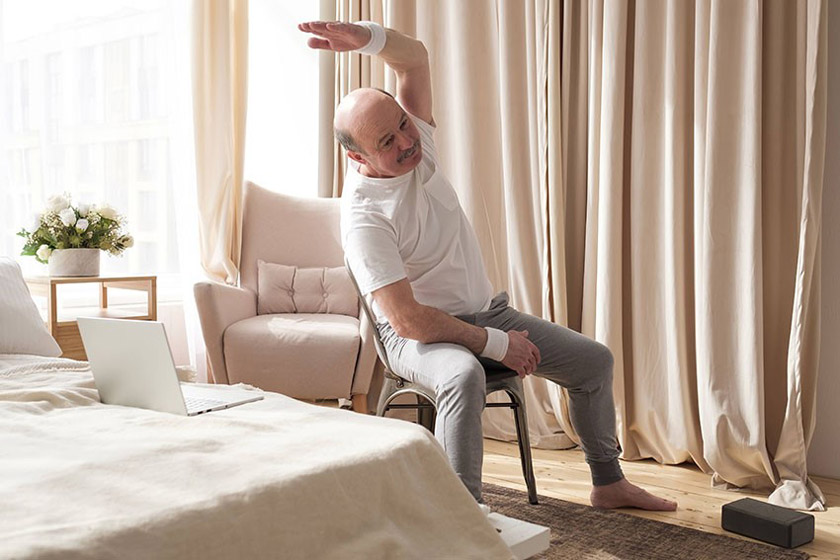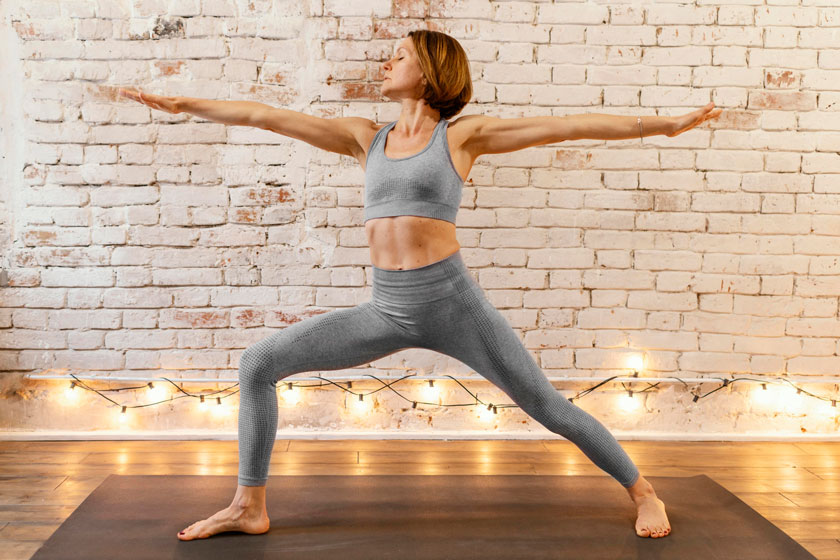Yoga is a study of life, the body, breath, mind, intellect, memory, and emotions. Gentle yoga refreshes the mind and body, strengthens the muscles, and keeps the inner organs and the hormonal system balanced. That is why people of all ages should practice yoga. Yoga can contribute to a more balanced and healthier lifestyle for seniors.
Is There an Age Limit for Yoga?
You can do yoga at any age — it’s just a case of picking the type of yoga that works for you and working within your abilities. Yoga can keep you young, stronger, and more flexible as you age. Yoga for seniors helps you maintain flexibility through low-impact exercise.
Benefits of Gentle Yoga for Seniors
Several studies have suggested that yoga for older adults is one of the best forms of exercise. Yoga helps seniors lose weight, and it is one of the exercises that can wake up your body and brain. With regular practice and a proper class, seniors can boost their strength, agility, flexibility and mood. Some of the benefits of yoga for seniors include:
- Reducing stress
- Strengthening bones
- Improving sleeping habit
- Lowering the risk of depression
- Enhancing balance, flexibility, mobility and strength
- Relieving aches and pains
- Losing weight
What Type of Yoga Is Best for Seniors?
What kind of yoga is most appropriate depends on your age, current physical fitness level, and physical ability. Following are five yoga types for seniors that may suit your needs:
- Hatha: Hatha yoga is known as beginning yoga. Typically, hatha yoga classes offer a series of postures, mainly seated or standing. Stretching and breathing are typically the focus, not heightening your heart rate.
- Iyengar: With a strong emphasis on proper form, Iyengar yoga is methodical and precise. This style of yoga is good for seniors with arthritis or chronic conditions as props allow for all kinds of modifications.
- Restorative: The goal of restorative yoga is to release tension without stretching passively. Pros are used to support the body completely, and poses may last up to 10 minutes. Restorative is the best type of yoga for the elderly who want to cultivate relaxation and contentment.
- Yin: Yin yoga is slow and emphasizes holding poses for a long time. The significant difference between restorative and yin yoga is restorative requires no active stretching, while yin involves stretching deep connective tissues. By practicing yin yoga regularly, you can relieve stiffness and regain flexibility.
- Vinyasa: This is a general term for yoga styles in which the movement aligns with the breath to form a continuous series of motions. Vinyasa emphasizes the transition between postures as much as the poses themselves. Pacing can vary greatly, but routines usually are quick and fluid. Seniors who are fit and able to practice Vinyasa yoga may enjoy the physical challenges.
Read More: Face Yoga for a More Youthful Face
Beginning Yoga for Seniors
There is a wide range of easy poses to choose from, including sitting, lying down, and chair yoga. Here are a few poses of beginning yoga for seniors.
Mountain
This beginning yoga pose is the starting position for all standing poses. Mountain pose improves posture and balance.
Mountain Pose Instruction:
- Put your feet slightly apart so that your big toes are touching. Extend your toes, then slowly rock back and forth. Reduce this swaying to a standstill by balancing your weight evenly on the feet.
- Press your shoulder blades into your back, then widen them so that they discharge down your back.
- Drop your lower front ribs without pushing them forward.
- Lift your sternum straight up toward the ceiling. Spread your collarbones and hang your arms beside the torso.
- Balance your head in the center of your pelvis, with your chin parallel to the floor, your throat soft, and your tongue wide and flat on your tongue’s floor.
- Breathe smoothly and hold the pose for 30 seconds.
Tree
The tree pose will strengthen your lower body and help improve your balance. It’s possible to do it with either your back against a wall or while sitting in a chair.
Tree Pose Instruction:
- With your left foot planted on your mat, open your right hip and place your right foot (onto the floor, a block, your opposite ankle, calf, or inner thigh).
- Find your balance by clasping your hands together in prayer at your heart. Once you feel stable and settled, open your arms out to the side to keep them parallel to the ground.
- Keep your hips square to the front and your lower body stable while twisting your upper body to the right.
- Hold for three to five breaths, noticing any changes in your energy on a return inhalation, then release.
- Repeat on the opposite side.
Tabletop Position
The table is a great starting point or transition point for many floor postures, and it helps realign the spine and lengthen it.
Table Pose Instruction:
- Come to the floor on your hands and knees. Bring your knees about hip-width apart and the feet directly behind your knees. Put your palms directly under your shoulders with your fingers pointing forward.
- Looking down between your fingers, allow the back to be flat, and then press from the palms towards the ears to slightly lower the shoulders. Push the tailbone towards the back, and the head crown towards the front wall, to lengthen the spine.
- Breathe deeply, hold for 1-3 breaths.
Cat-Cow Pose
The yoga cat-cow pose makes your spine flexible while strengthening your abdomen. This video will show you how to do this pose correctly.
Cat-Cow Pose Instruction:
- Stand on your hands and knees in a “tabletop” position. Hold your elbows exactly vertical and your wrists parallel to the floor. Your head should be in a neutral position with your eyes looking at the floor.
- Keep your shoulders and knees in place as you exhale, rounding your spine toward the ceiling. Inhale deeply, releasing your head toward the floor. Don’t force your chin toward your chest.
- Return to the “tabletop” position. Make sure your knees are directly beneath your hips, and your wrists, elbows, and shoulders are straight and exactly vertical to the floor
- Center your head in a neutral position, eyes looking at the floor.
- While inhaling, lift your head to look straight ahead, raise your chest to reach the ceiling, and let your belly sink toward the floor.
- Inhale and return to “tabletop” position.
Chair Yoga for Seniors

Chair yoga is an excellent exercise for seniors. This type of exercise refers to how yoga poses you can do while seated. These modifications allow seniors with low mobility to benefit from yoga. You can do twists, hip stretches, forward bends, and mild backbends while sitting. In addition to the fitness benefits of stretching, chair yoga for seniors can improve muscle tone and breathing habits, reduce stress, and improve your sleep quality and mood.
Can Seniors Lose Weight Doing Chair Yoga?
Due to many reasons maintaining a healthy weight and BMI range is essential to seniors. Weight loss for the elderly is possible through chair yoga. Chair yoga has all the benefits of regular yoga practice, including muscle toning, a sense of wellbeing, and improved breathing patterns.
How Many Days Should I Do Yoga in a Week?
The number of yoga sessions seniors should practice in a week varies from person to person and depends on your goals:
To start, if you want to gain the benefits of yoga – including improved concentration, strength, and flexibility – it is to schedule 2-3 half-hour sessions each week. A ten-minute gentle yoga session before bed can improve your sleep. One session of beginning yoga a week may be enough to improve flexibility. However, faster progress is possible if you practice more.
Which Yoga Exercises Should Seniors Avoid?
Seniors with limited mobility can still do gentle yoga through adaptive practices, such as chair yoga. Water yoga is also a great beginning yoga for seniors, as the body is less weighted and can move more easily underwater.
If you have arthritis, yoga can be an excellent complement to your treatment, but be careful when choosing a class. Look for instructors who have experience working with seniors with arthritis. If you suffer from spinal disc disorders or glaucoma, be sure to speak to your doctor before attempting yoga. Twisting poses and inversions are especially dangerous for those with these conditions.
Final Words
Yoga for seniors is among the best exercises. As a senior, it’s best to do your research before starting yoga. Choose a gentle yoga class that’s easy to do and know your limits. No matter how fit you are, seniors will benefit from yoga and chair yoga just as much as young adults.
